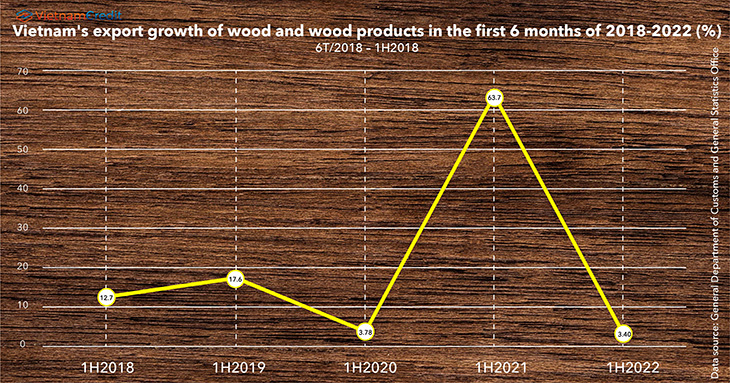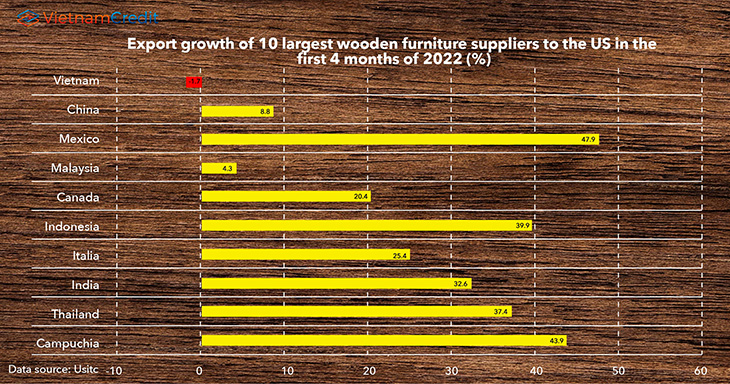The export growth of the wood industry is slowing down due to high inflation in many countries which prompts consumers to tighten spending, while logistics costs and prices of input materials are continuously increasing. Besides, the US is also increasing trade remedies.

According to the General Statistics Office, Vietnam's exports of wood and wood products in June reached $1.5 billion, up 12.5% over the previous month but down 1.8% over the same period last year. Generally, in the first 6 months of the year, the export turnover of wood and wood products was estimated at $8.5 billion, up 3.4% over the same period last year.
However, this growth is significantly lower than the expectation of 5-8% increase by the Vietnam Timber and Forest Products Association (VIFOREST) and even lower than the growth rate of 3.8% in the first 6 months of 2020 when the COVID-19 epidemic began to break out globally.
Compared to the export target of $18 billion USD, the wood industry has completed less than half (47.2%) of the plan.
Although many furniture manufacturing enterprises have had orders until the third quarter or even the fourth quarter of 2022, there are new factors appearing in the market that directly affect the production and business activities of this industry.
The Import-Export Department (Ministry of Industry and Trade) said that the export of wood and wood products slowed down in the first months of this year mainly due to high inflation in many main export markets, prompting consumers to tighten spending.
Besides, freight charges are high. The prices of imported goods, raw materials, and materials used as inputs for production all increased sharply due to scarce supply caused by the conflict between Russia and Ukraine. In addition, the “Zero COVID” policy in China also has negative impacts.
Difficulties in major markets
Experts believe that another important reason why the growth rate of the wood industry has slowed down is export to the US (which consumes 60% of Vietnam's wood and wood products) which is showing signs of declining after a boom period.

Data from the General Department of Customs shows that in the first 5 months of this year, Vietnam's exports of wood and wood products to the US market only increased modestly by 1.6% over the same period last year, reaching $4.1. billion. This is a rather low increase compared to the double-digit growth rate in previous years.
Meanwhile, according to data from the US International Trade Commission (USITC), in the first 4 months of 2022, the US spent more than $8.8 billion importing wooden furniture from the world, an increase of 11.4%. compared to the same period in 2021.
Vietnam is still the largest supplier of wooden furniture to the US, but its market share has decreased from 40% to 35%.
Notably, among the 10 largest export markets of wooden furniture to the US, only Vietnam recorded a decline in the first 4 months of this year, with a decrease of 1.7% to more than $3 billion.
In particular, products that recorded the strongest decline were office furniture (down 39.2%) and living room & dining room furniture (down 10.2%).
The demand for imported furniture in the US is still increasing strongly, but Vietnam's wood industry is facing trade remedies in this market, the Import-Export Department said.
In early June, the US Department of Commerce (DOC) announced the initiation of an investigation into evasion of anti-dumping and anti-subsidy tax on wooden cabinets imported from Vietnam. The plaintiff alleges that the Vietnamese enterprises use wood parts imported from China that are within the scope of application of the trade remedy measures that the US is applying.
In the list of 11 groups of export products at risk of being subject to trade remedies, updated by the Trade Remedies Administration (Ministry of Industry and Trade) by the end of November 2021, the wood industry has 4 products at risk of being subject to anti-circumvention, origin fraud, illegal transshipment or trade remedy measures in the United States.
These products include plywood from solid wood materials, wooden cabinets, sofas with wooden frames, wooden bars and strips of wood.
Short-term forecast
Binh Duong Furniture Association (BIFA) predicts that the wood industry will face great challenges in the last months of 2022.
According to a survey by BIFA, in the near future, many wood processing factories in Binh Duong such as Karta Joint Stock Company, TPP One Company may not have orders for production. Some enterprises have also seen a decline in new contracts compared to 2021 (such as Thinh Phat Tan Uyen Wood Trading & Production Company Limited, An Khang Company Limited, and Interwood Co., Ltd.)
A representative of a wood processing company said that most businesses are currently facing high input costs including gasoline, logistics costs, coating chemicals, etc., leading to very high product prices. Therefore, some businesses limit receiving new orders if they cannot negotiate the suitable price.
Source: vietnambiz
Related News
- HawaExpo hopes to help wood processing industry regain growth momentum
- 2024 remains challenging for wood sector: experts
- Wooden products begin to get export orders again after lull
- Wood exports to U.S. decline due to inflation
- SMEs near breaking point: report
- Wood exports to US & EU still struggling
- Vietnamese wood exporters grapple with waning demand
- Artisan communities strive for legal wood

 Tiếng Việt
Tiếng Việt




